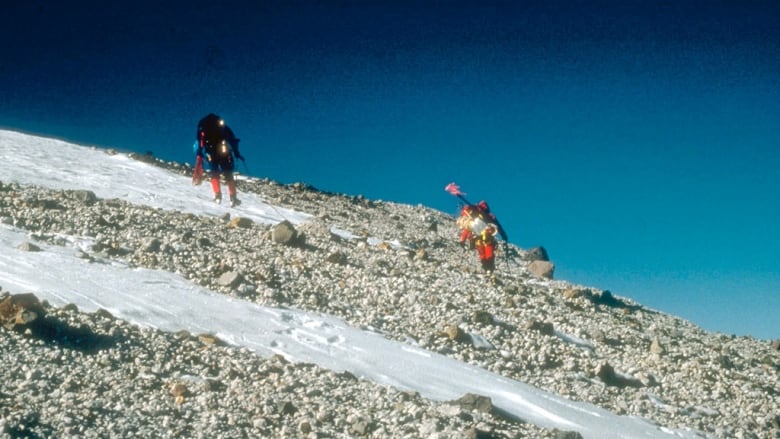Ancient Alaska volcano spewed ash across continents
Eruption of Mt. Churchill in 850 left traces as far as Newfoundland and Germany

A volcanic eruption 1,150 years ago on the Yukon-Alaska border is shaking up what scientists know of how ash gets spewed by such explosions, and sending a caution to the airline industry about future massive interruptions.
The eruption around 850 AD of Mount Churchill in southeastern Alaska deposited ash over an area previously thought to include an eastern strip of the U.S. state, southern Yukon, northern B.C. andparts of the Northwest Territories.
The resulting phenomenon of the so-called White River Ash is well known in those areas: In road cuts in Alaska and the Yukon, a starch-white layer up to half a metre thick can be seen just below ground.
If the White River eruption was able to do that, then maybe other eruptions were able to do that.- Britta Jensen, geoscientist
But now geo-scientists from the University of Alberta and elsewhere have proposed that the eruption reached much farther to Atlantic Canada, Greenland and Europe.
Instead of a prior range of about 1,000 kilometres, the researchers say they found White River ash particles as far as 7,000 km from the volcano.
No one wouldve expected that a modest eruption from North America would have deposited ash in Europe, said Britta Jensen, lead author of the research findings.
The results suggest other moderate volcanic eruptions such as those that have occurred in the U.S. Northwest or Russia may have left intercontinental ash traces, as well.
They also suggest that an eruption on this scale, which occurs once every 100 years on average,could have more seriousconsequences for global air travelthan even the Icelandic ash cloud of 2010, which closed European airspace for five days, because of the larger area that can be affected.
Ash deposits linked
For decades, European geologists had known of an ash deposit in Greenland and Northern Europe that was assumed to have come from a volcano in Iceland.
But at a conference in 2011, scientists from both sides of the Atlantic began to feel that the European deposits were linked to the White River ash layer in Alaska and Northern Canada, Jensen said.
To test that theory, Jensen and her colleagues examined ash samples from Yukon, Nova Scotia, Greenland, Northern Ireland and Germany. They assessed the chemical composition and ages of the samples, and looked at the shape and texture of glass residues in the ash.
The geochemistry of every single eruption is unique, explained Jensen, who did the bulk of her work for her PhD at the University of Alberta. So we create this geo-chemical fingerprint for each eruption, and once we have done that we can find it anywhere else it may exist.
The conclusion: The fingerprint for the European and North American samples were the same and could have only come from the Mount Churchill eruption.
Its not at all what would have been expected. The White River was a large eruption, but it wasnt exceptional, Jensen said. From these regular size of eruptions, we dont expect ash to go that far, so we didnt look for it.
John Westgate, an emeritus professor of Earth sciences at the University of Toronto who has studied the White River ash but did not contribute to this latest paper, called the findings a real breakthrough.
It allows us to reconstruct the geological histories of areas very distant from one another, he said.
Because volcanic ash is normally deposited in a layer over a narrow time frame, from a day to a few weeks, it forms a marker that can permit scientists to correlate the timing of geological evidence such as fossils from two vastly different areas.
It allows us to get some idea of what the climate was like at the time, what vegetation was like, what animals were roaming in that landscape, Westgate said. And when you study successions of ash beds, you can build up a story of environmental change through time.
Air travel concerns
But the results published in the current issue of the scientific journal Geology also sound a cautionary note about future volcanic eruptions.
The Mount Churchill blast that produced the White River ash is the kind of global volcanic event that occurs roughly every 100 years, on average.
Now that its known the ash cloud from such an event can spread up to 7,000 km away seven times farther than thought the air travel industry could be facing a much wider area of hazardous flight paths in the event of an eruption. Domestic routes in the U.S. Northeast and Canada, as well as transatlantic flights, would be at risk, said Jensen, who is now doing post-doctoral work at Queens University in Northern Ireland.
While the 2010 eruptions at Eyjafjallajkull in Iceland closed much of European airspace for five days, a blast of the magnitude of Mount Churchill would be around 100 times more powerful.
An eruption of this size hasnt happened since modern aviation, but its something we cant discount. It may not happen in my lifetime, but its something we should expect, Jensen said.












_(720p).jpg)


 OFFICIAL HD MUSIC VIDEO.jpg)
.jpg)



























































































